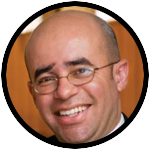
Hosffman Ospino
U.S. Catholicism and the Hispanic experience in the second decade of the 21st century practically go hand in hand. The evidence? Well, just look around. Look at the families attending Mass in our parishes, the children being baptized and receiving first Communion, the faces of young Catholics today, the various rhythms that give life to liturgical music in our parishes, among other signs.
In thousands of faith communities, these faces and expressions are Hispanic. This goes without mentioning the widespread use of Spanish as a language for Catholic affairs. In many parts of the country, Catholicism is a de facto bilingual reality (i.e., English and Spanish).
The Hispanic presence is most accentuated in some parts of the country, like the South and the West. It is impossible to miss it in virtually every major urban setting of our vast geography. Take the 10 largest cities in the country according to population (in this order): New York; Los Angeles; Chicago; Houston; Philadelphia; Phoenix; San Antonio; San Diego; Dallas; and San Jose, California. In most of them, the majority of Catholics are Hispanic.
[hotblock]
Much has changed demographically and culturally about American Catholicism during the past five decades. At the heart of those transformations is the fast-growing Hispanic presence, both immigrant and U.S.-born. Along with immigrants and U.S. Catholics of other races and ethnicities, Hispanics are writing a new and exciting chapter in the history of what it means to be American and Catholic.
For almost half of American Catholics, being Hispanic and Catholic is not news: It is who we are! It is about our cultural worldviews and traditions, the languages we speak and the many ways we experience the mystery of Jesus Christ as Hispanics. We see the world and our faith through Hispanic Catholic eyes.
For the rest of U.S. Catholics, the Hispanic presence is an invitation to affirm particular ways of living the faith, old and new, while embracing their Hispanic sisters and brothers on a shared journey as we all continue to build vibrant communities, faithful families and a stronger society rooted in the values of the Gospel.
With these realities in mind, during the next four years, January 2017 through December 2020, the Catholic Church in the United States is embarking on a most amazing ecclesial experience: the Fifth National Encuentro of Hispanic/Latino Ministry (a.k.a., V Encuentro). This is a multiyear process of reflection, evangelization and consultation that aims at engaging about 8 million Catholics in more than 5,000 parishes and almost every diocese in the country.
The V Encuentro has a twofold goal: Discern how the church can better embrace the Hispanic/Latino presence, and strengthen the ways Hispanics/Latinos respond as church to the call to a new evangelization. Though the emphasis is on Hispanic Catholics, given the size of this population and its impact upon thousands of faith communities nationwide, all U.S. Catholics are invited to join in the V Encuentro process.
Pope Francis himself has recognized the importance and potential of the V Encuentro and its focus. In November 2016, speaking from Rome, he addressed the Catholic bishops of the United States, affirming:
“It is my hope that the church in your country at every level will accompany the Encuentro with its own reflection and pastoral discernment. In a particular way, I ask you to consider how your local churches can best respond to the growing presence, gifts and potential of the Hispanic community.”
Yes, this is a unique moment to be a church that goes forth in the spirit of the V Encuentro, a great time to contemplate American Catholicism “through Hispanic Catholic eyes.”
***
Ospino is professor of theology and religious education at Boston College. He is a member of the leadership team for the Fifth National Encentro of Hispanic/Latino Ministry.
PREVIOUS: Homicides take the heart out of us, but education remains the key
NEXT: Trump and the forgotten America of the Fourth World



Share this story